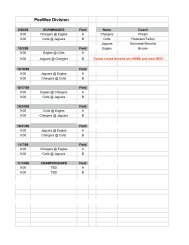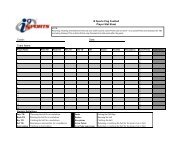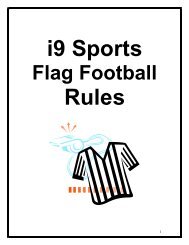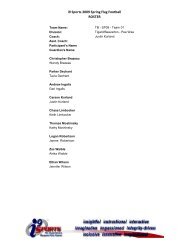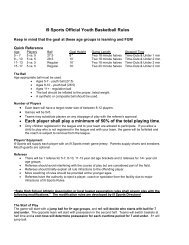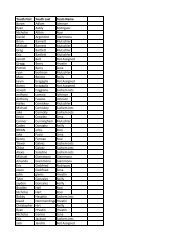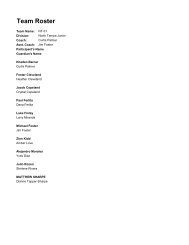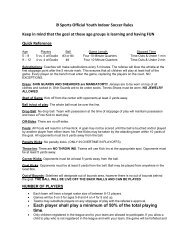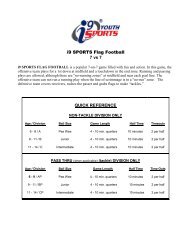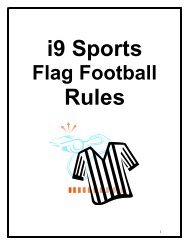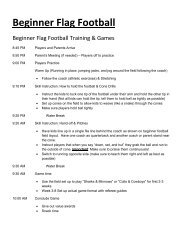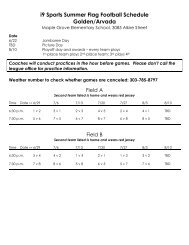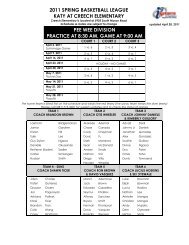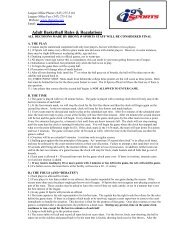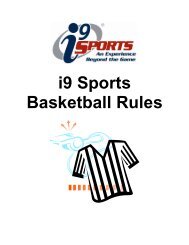i9 Sports 5 vs. 5 Outdoor Flag Football Official Rules
i9 Sports 5 vs. 5 Outdoor Flag Football Official Rules
i9 Sports 5 vs. 5 Outdoor Flag Football Official Rules
Create successful ePaper yourself
Turn your PDF publications into a flip-book with our unique Google optimized e-Paper software.
<strong>i9</strong> <strong>Sports</strong> 5 <strong>vs</strong>. 5 <strong>Outdoor</strong> <strong>Flag</strong> <strong>Football</strong> <strong>Official</strong> <strong>Rules</strong><br />
(Updated April 9, 2010)<br />
<strong>i9</strong> <strong>Sports</strong> <strong>Flag</strong> <strong>Football</strong> is a popular five-on-five game filled with fun and action. In this game, the offensive team plays for a<br />
first down at midfield and a touchdown in the end zone. Running and passing plays are allowed, although there are “norunning<br />
zones” at midfield and near each goal line. The defensive team covers receivers, rushes the passer, and grabs flags<br />
to make “tackles.”<br />
The Basics<br />
• A coin toss determines first possession.<br />
• The offensive team takes possession of the ball at its 5-yard line and has four plays to cross midfield. Once a team<br />
crosses midfield, it has four plays to score a touchdown. If the offense fails to score, the ball changes possession and<br />
the new offensive team takes over on its 5-yard line.<br />
• If the offensive team fails to cross midfield, possession of the ball changes and the opposition starts its drive from its 5-<br />
yard line.<br />
• All possession changes, except following interceptions, start on the offense’s 5-yard line. Interceptions may be run<br />
back.<br />
• Teams change sides after the first 20 minutes. Possession changes to loser of coin toss.<br />
• The ball may be snapped either between the legs or to the side in all age divisions.<br />
• It is a guideline, but not a rule, that we strongly recommend that coaches ensure that each player has at least two<br />
ball touches each half.<br />
Field dimensions are: 50 yards long x 30 yards wide with 7-yard end zones. There are 5-yard no-run zones before the midfield<br />
line and goal lines.<br />
Players<br />
Teams must field a minimum of five players at all times unless both teams agree to play with four a side (min.).<br />
Timing/Overtime<br />
Games are played in two 20-minute halves with a running clock and a one-minute halftime. Clock will stop in last one<br />
minute of each half. Each time the ball is spotted, a team has 30 seconds to snap the ball. Teams will receive one warning<br />
before a delay-of-game penalty is enforced. Each team has two 30-second time-outs per half. <strong>Official</strong>s can stop the clock<br />
at their discretion. There is no overtime in the regular season. Playoff game overtime: each team receives a possession<br />
from the midfield line and four downs to score. If a team scores a touchdown, they can choose to go for either a one- or<br />
two-point conversion. The second overtime, if needed, follows the same procedure. If a third or more overtimes are<br />
needed, teams MUST go for a two-point conversion after each touchdown they score. Each team may use one time-out<br />
per overtime.<br />
Scoring<br />
Touchdown: 6 points.<br />
Extra point: 1 point (played from 5-yard line) or 2 points (played from 12-yard line). There is no runback by the defense<br />
permitted on an extra point.<br />
Safety: 2 points<br />
Forfeit: Any game forfeited will be scored as 7-0<br />
Mercy rule<br />
Once a team gets down by 24 or more points, the mercy rule will be in effect. This means that after the team that scores<br />
leads by 24 or more points, the trailing team will take its possessions from one yard outside the no-run zone near midfield<br />
(i.e., six yards from the midfield line) instead of at its own five-yard line. That team still has four downs to cross midfield for a<br />
first time and, if successful, another four downs to then score a touchdown. The team that is behind will be allowed to play<br />
with six players. The team in the lead will not be permitted to runback interceptions, but will take over on offense at the spot<br />
of the interception. Should the trailing team close to within 24 points, then the normal rules of play will again apply.<br />
Running<br />
The quarterback can run with the ball directly from the snap only in the 4-6, and 7-9 age groups. The quarterback cannot<br />
run with the ball in older age groups unless it has been handled by another player and returned to the quarterback (like a<br />
reverse or flea-flicker). Direct handoffs and pitches behind the line of scrimmage are permitted. Offense may use multiple<br />
handoffs or pitches, as long as they are behind the line of scrimmage. Should the ball hit the ground, it’s dead. The player<br />
who takes the handoff or pitch can throw the ball from behind the line of scrimmage. Once the ball has been handed off<br />
or pitched, all defensive players are eligible to rush. Spinning is allowed, but players cannot leave their feet to avoid a<br />
defensive player (no diving). The ball is spotted where the ball carrier’s feet are when the flag is pulled, not where the ball<br />
is.<br />
“No-running zones” located five yards from each end zone and five yards on either side of midfield are designed to avoid<br />
short-yardage, power-running situations. The offensive team cannot run a running play when the line of scrimmage is in a<br />
“no-running zone” and the forward pass must cross the line of scrimmage.
Receiving<br />
All players are eligible to receive passes (including the quarterback if the ball has been handed off or pitched behind the<br />
line of scrimmage). As in the NFL, only one offensive player is allowed in motion at a time after the team has set itself at the<br />
line of scrimmage. A player must have at least one foot in-bounds when making a reception.<br />
Passing<br />
Passes do not have to cross the line of scrimmage. Shovel passes are allowed. The quarterback has a seven-second “pass<br />
clock.” If a pass is not thrown within the seven seconds, the play is dead, loss of down. Once the ball is handed off or<br />
pitched, the seven-second rule no longer is in effect. Interceptions change the possession of the ball at the end of the run<br />
back. Interceptions are the only changes of possession that do not start on the 5-yard line.<br />
Dead Balls<br />
Substitutions may be made on any dead ball. Play is ruled “dead” when:<br />
— Ball carrier’s flag is pulled<br />
— Ball carrier steps out of bounds<br />
— Touchdown or safety is scored<br />
— Ball is intercepted by the defense on a conversion attempt<br />
— Ball carrier’s knee or any other body part except a hand hits the ground<br />
— Ball carrier’s flag belt falls off<br />
Note: There are no fumbles. The ball is spotted where the ball hits the ground.<br />
Note: There are no kickoffs, and no blocking is allowed.<br />
Rushing the Quarterback<br />
All players who rush the passer must be a minimum of seven yards from the line of scrimmage when the ball is snapped.<br />
Any number of players can rush the quarterback. Players not rushing the quarterback may defend on the line of<br />
scrimmage. Once the ball is handed off, pitched, or thrown, the seven-yard rule no longer is in effect and all defenders<br />
may go behind the line of scrimmage. A special marker, or the referee, will designate seven yards from the line of<br />
scrimmage. Remember, no blocking or tackling is allowed.<br />
<strong>Sports</strong>manship/Roughing<br />
If the field monitor or referee witnesses any acts of tackling, elbowing, cheap shots, blocking or any unsportsmanlike act, the<br />
game will be stopped and the player will be ejected from the game. FOUL PLAY WILL NOT BE TOLERATED. Trash talking is<br />
illegal. <strong>Official</strong>s have the right to determine offensive language. (Trash talk is talk that may be offensive to officials,<br />
opposing players, teams, or spectators.) If trash talking occurs, the referee will give one warning. If it continues, the player<br />
or players will be ejected from the game.<br />
Defensive Penalties<br />
Offsides<br />
Pass interference<br />
Illegal contact (holding, blocking, etc.)<br />
Illegal tackle (grabbing ballcarrier’s shirt, pants, etc.)<br />
Illegal flag pull (before receiver has ball)<br />
Illegal rushing (starting rush from inside 7-yard marker)<br />
Offensive Penalties<br />
Illegal motion (more than one person moving, false start, etc.)<br />
Illegal forward pass (pass thrown beyond line of scrimmage)<br />
Pass interference (illegal pick play, pushing off/away defender)<br />
<strong>Flag</strong> guarding<br />
Second delay of game<br />
Five yards, repeat down<br />
Seven yards from previous spot, repeat down<br />
Seven yards from previous spot, repeat down<br />
Seven yards from spot of foul<br />
Seven yards from spot of foul<br />
Five yards, repeat down<br />
Five yards, repeat down<br />
Five yards and loss of down<br />
Seven yards from previous spot, repeat down<br />
Seven yards from spot of foul<br />
Clock stops, five yards and loss of down<br />
Referees determine incidental contact that may result from normal run of play. Only the team captain may ask the referee<br />
questions about rule clarification and interpretations. Players cannot question judgment calls. Games cannot end on a<br />
defensive penalty, unless the offense declines it.<br />
Attire<br />
Cleats are allowed, except for metal spikes. Inspections must be made. All players must wear a protective mouthpiece;<br />
there are no exceptions.<br />
No pockets or hoops on shorts. No hats with brims or bills. <strong>Official</strong> <strong>i9</strong> <strong>Sports</strong> jerseys must be worn during play.<br />
Post-season<br />
Playoff formats will be determined by the league office. Ties in the standings will be broken as follows:<br />
- First tie-breaker is record in head-to-head competition. If more than two teams are tied, then record in games against all<br />
of those tied teams is considered first.<br />
- Second tie-breaker is points scored/allowed differential in all games played.<br />
- Third tie-breaker is points differential in head-to-head games played.<br />
- Fourth tie-breaker is a coin flip.<br />
“An Experience Beyond the Game!”



